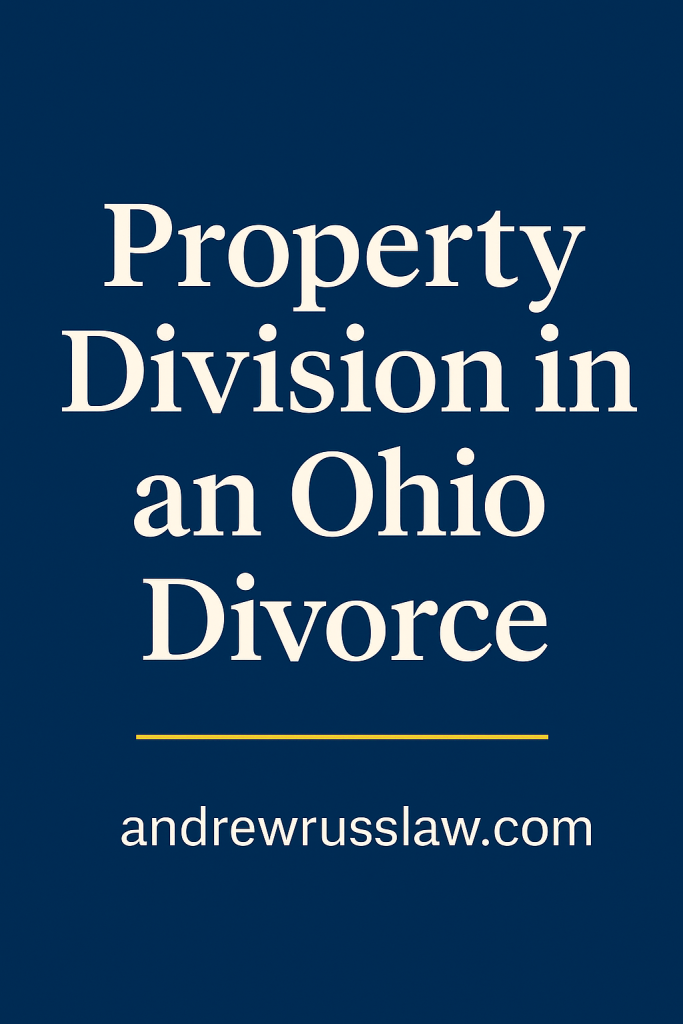Property Division in an Ohio Divorce: A Guide
- Aug 1
- 6 min read
By Andrew Russ, Ohio Divorce Attorney

Property Division in an Ohio Divorce | Andrew Russ Law
Learn how Ohio courts handle property division in divorce. Discover equitable distribution rules, marital vs. separate property, valuation, and tips to protect your assets with insights from Andrew Russ Law.
Introduction
Dividing property in an Ohio divorce is often one of the most complex and emotionally charged aspects of ending a marriage. Whether you have been married for a few years or several decades, the process involves more than just splitting assets down the middle. Ohio law follows the principle of equitable distribution, which aims for fairness—but not always equality—based on the unique facts of each case.
If you are preparing for a divorce in Ohio, understanding how property division works can help you protect your financial interests and avoid costly mistakes. As an experienced Ohio divorce attorney, I guide clients through this process every day, ensuring they understand their rights, responsibilities, and potential outcomes.
This article covers everything you need to know, including:
The difference between marital and separate property
How Ohio’s equitable distribution laws work
The valuation process for assets
Division of real estate, retirement accounts, and business interests
Factors courts consider in dividing property
Protecting your assets during divorce

1. The Legal Framework for Property Division in Ohio
Ohio property division laws are governed primarily by Ohio Revised Code § 3105.171. The statute outlines how courts classify, value, and divide property during a divorce. Unlike community property states (which require a 50/50 split), Ohio follows equitable distribution, meaning the court aims for a fair—but not necessarily equal—division.
Key points under Ohio law:
Marital property is generally divided equitably between the spouses.
Separate property is typically awarded to the spouse who owns it.
Courts have broad discretion to consider the circumstances of both spouses.
Tip: Equitable distribution does not mean equal—it means fair. Depending on the facts, one spouse may receive a larger portion of certain assets.
2. Understanding Marital vs. Separate Property
A critical first step in property division is determining whether each asset is marital or separate property.
Marital Property
Generally includes:
Income earned during the marriage
Real estate purchased during the marriage
Retirement accounts accrued during the marriage
Personal property such as vehicles, furniture, and jewelry acquired during the marriage
Business interests created or expanded during the marriage
Separate Property
Generally includes:
Assets owned prior to marriage
Inheritances received by one spouse alone (even during marriage)
Gifts given specifically to one spouse
Compensation for personal injuries (with exceptions)
Property explicitly excluded by a prenuptial agreement
Important: The burden of proof to show that an asset is separate falls on the spouse claiming it.
Example:
If you owned a home before marriage, it may be separate property. However, if marital funds were used for mortgage payments or renovations, part of its value may be considered marital.
3. Commingling and Tracing Assets
Sometimes, separate property can become marital property through a process known as commingling—when marital and separate funds are mixed together. If commingled assets can still be traced back to their original source, courts may treat part of them as separate property.
Example:
If you deposit inherited money into a joint account and use it for household expenses, it may lose its separate status unless clear records exist.
4. Valuing Marital Assets
Ohio courts require a fair market valuation of assets before division. Valuation is especially important for high-value items and complex holdings.
Common valuation methods:
Real estate: Professional appraisal
Vehicles: Kelley Blue Book or similar
Businesses: Business valuation expert
Retirement accounts: Statement balances plus actuarial analysis for pensions
Collectibles: Specialist appraisals
Pro Tip: Accurate valuation can prevent one spouse from receiving significantly more value than the other.
5. Division of Real Estate in Ohio Divorce
For many couples, the marital home is their largest asset. Ohio courts may handle it by:
Selling the property and dividing proceeds
Awarding the home to one spouse (often the custodial or residential parent) with a buyout of the other spouse’s interest
Deferring sale until a certain event (e.g., youngest child turns 18)
Factors considered:
Who has custody of children
Ability of each spouse to maintain the home
Financial feasibility of a buyout
6. Retirement Accounts and Pensions
Retirement assets are subject to division if accrued during the marriage. This may include:
401(k) plans
Pensions
IRAs
Military retirement benefits
Division is typically handled through a Qualified Domestic Relations Order (QDRO), which ensures tax-deferred status is preserved.
Note: Only the portion earned during the marriage is marital property. Pre-marital balances remain separate.
7. Dividing Businesses and Professional Practices
If one or both spouses own a business, the court must determine:
The business’s fair market value
Whether it is marital, separate, or a mix
Whether one spouse will buy out the other or if the business will be sold
Valuation often requires:
Forensic accountants
Earnings analysis
Goodwill assessment
8. Debt Division in Ohio Divorce
Just as assets are divided, marital debts must also be split. This includes:
Mortgages
Car loans
Credit card balances
Business debts
Debts incurred for marital purposes are generally divided equitably. However, if a debt was incurred by one spouse for non-marital purposes (e.g., gambling), that spouse may be assigned full responsibility.
9. Factors Courts Consider in Property Division
Ohio courts weigh multiple factors under O.R.C. § 3105.171(F), including:
Duration of the marriage
Assets and liabilities of each spouse
Desirability of awarding the family home to the custodial parent
Liquidity of property
Tax consequences of division
Costs of selling property
Retirement benefits
Any intentional destruction or concealment of assets
10. Tax Considerations in Ohio Property Division
Failing to consider taxes can lead to unexpected consequences:
Transfers of property incident to divorce are generally non-taxable under IRS rules.
However, selling assets post-divorce may trigger capital gains taxes.
Retirement account withdrawals before age 59½ may incur penalties unless done via a QDRO.
11. Protecting Your Assets During Divorce
Steps to take:
Gather and organize financial documents
Keep separate property separate
Avoid dissipating marital assets
Work with an experienced divorce attorney
Consider mediation for a controlled settlement
12. Alternative Dispute Resolution (ADR) for Property Division
Instead of leaving property division entirely to a judge, couples can use:
Mediation – A neutral third party helps spouses reach agreement
Collaborative divorce – Attorneys work together toward settlement without court intervention
These methods can:
Reduce legal fees
Provide more control over the outcome
Preserve a cooperative relationship
13. Modifying Property Division After Divorce
Unlike child support or custody, property division orders are final and cannot be modified—except in cases of fraud, concealment of assets, significant clerical errors, or upon the express written consent or agreement to the modification by both spouses.
14. Common Mistakes to Avoid
Failing to identify all marital assets
Assuming equal division is guaranteed
Overlooking retirement benefits
Forgetting tax implications
Neglecting to address debts
Not hiring professionals for valuation
15. Why You Need an Experienced Ohio Divorce Attorney
Property division in an Ohio divorce can significantly impact your financial future. An experienced attorney can:
Correctly classify property
Ensure accurate valuations
Protect your separate property rights
Negotiate a fair settlement
Advocate for you in court if necessary
At Andrew Russ Law, I help clients navigate complex property division issues with skill and care. My goal is to protect your financial future while minimizing unnecessary conflict.

Conclusion
Property division in an Ohio divorce is rarely straightforward. From determining what’s marital versus separate, to valuing assets and addressing debts, the process requires careful planning and legal guidance. Understanding Ohio’s equitable distribution laws is essential for protecting your rights and securing a fair outcome.
If you are facing divorce and have concerns about property division, contact Andrew Russ Law today. I will walk you through your options, safeguard your assets, and help you move forward with confidence.
Related Blog Posts
Ready to protect your property in a divorce? Call Andrew Russ Law today at or request a consultation through our Contact Form.
LINKS:




